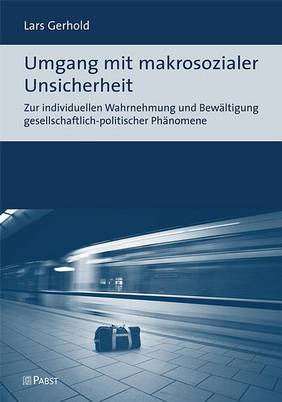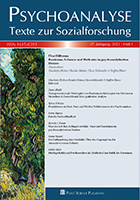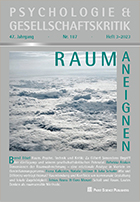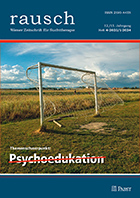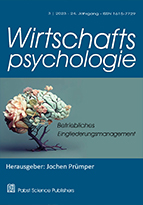Natural resources such as oil, phosphorus, and minerals are being depleted, dangerous climate change is upon us, a majority of species diversity might go extinct in the coming decades, and systemic risks such as the outbreak of a pandemic disease increase on a crowded and highly interconnected planet. Some scientists think that environmental collapse is imminent [1], because we are about to cross biophysical thresholds with "disastrous consequences for humanity [2], and therefore we have according to a UNEP report written by the 18 winners of the unofficial Nobel prize for the environment "no choice but to take dramatic action to avert a collapse of civilisation [3]. But what do these predictions mean for our culture and society?
From the wild to post-collapse
At a recent symposium co-organized by the University of Zurich and ETH with the title "From the wild to post-collapse [4] an interdisciplinary and international group of about fifty graduate students and researchers representing the natural sciences, social sciences and humanities, together with artists, explored ways of imagining possible futures in a time of environmental crisis. The symposium was organised by the recently founded Swiss Environmental Humanities group [5]. Environmental humanities is an emerging research field that is attracting major attention around the world. It brings scholars from the humanities and arts into conversation with natural scientists and professionals to rethink environmental problems from a cultural perspective.
A third path between optimism and pessimism
Language shapes our thinking and imagination as well as the direction science takes [6]. Sustainability denotes the current paradigm of environmental sciences and environmentalism, but sustaining and optimising our existing economic and social systems will not be sufficient for avoiding overexploitation of ecological systems. Apocalyptic diagnosis is common in the environmental sciences, but it diverts creativity away from positive utopian thinking. "Are we prepared for post-collapse? seems a strange guiding question for an environmental symposium, but it proved to be a productive starting point for transdisciplinary conversations. We uncovered how such diverse sciences as ecology and medicine oscillate between optimism and pessimism. In different intellectual arenas opposing visions collide and often divide people instead of uniting them. Conservationists for instance feel increasingly to be in two camps, that of traditionalists who want to save wilderness or restore it, or else futurists who want to embrace novel ecological realities and design artificial ecosystems for the 21st century. Traditionalists think that futurists accelerate environmental degradation by encouraging people to forget pristine nature and to believe in an endless ability to fix ecological destruction. Futurists think that traditionalists misspend resources for unrealistic causes and alienate people from the everyday nature that surrounds them.
Imagining alternative environmental futures
The symposium confronted participants with alternative stories about environmental futures: the wild, the re-wilded, collapse, and post-collapse. We discussed how these notions connect to different cultural contexts, our history, hopes, fears, and creativity. And we asked whether they trigger innovation, scientific breakthroughs, action, and solutions, or hinder them. We hoped that such explorations would help us to reinvent, connect and transgress our current imaginations of the future to overcome paralysis. The symposium produced no answers but questions that might lead towards new ideas:
- The wild and the re-wilded: Is it futile to save last remnants of untouched wilderness, traditional lifestyles, and indigenous cultures, or can these reminiscences of the past live on in a world that is no longer theirs? Is it worth saving the last individuals of a rhinoceros species in a deforested landscape in Borneo or should efforts be abandoned to save resources for more realistic goals? Indeed, how can we talk about the beauty of lost nature without being nostalgic and pessimistic?
- Collapse: Environmental scientists and environmentalists have come to live with doomsday scenarios about environmental collapse. But does apocalyptic diagnosis indeed promote change or rather encourage inaction? For most of us, an imminent apocalypse represents an unavoidable future for which human choices and actions do not matter. Psychologists and other social scientists know that fear, trauma, and alarmist communication paralyse rather than mobilize people. How can we find hope in scenarios of disaster?
- Post-collapse: Is it true that wildlife proliferates in post-collapse landscapes around Chernobyl? Can times of post-collapse be moments of change, innovation, or resurrection? Indeed, is it time to prepare for the least problematic post-collapse scenario, or would this be fatalistic and irresponsible at a time when we should join all forces to avoid systemic collapse?
There will be no simple answers and we might depend on paradoxical thinking: imagining post-collapse for avoiding collapse, designing nature for saving wilderness, restoring memories of the past for working toward a fundamentally novel future. A new opportunity for debate will be on November 27 at Corner College [7]: "Should we conserve, re-wild, or redesign nature?
This blog owes much to inspiring discussions with Philippe Forêt, Marc Hall, and the participants of the June symposium.
References
[1] Jared Diamond. "Collapse". Viking Press, New York. See
[2] Rockström et al. 2009. A safe operating space for humanity. Nature 461: 472-475
[3] The Guardien: Article
[4] Symposium: Abstract
[5] www.eh.saguf.ch/
[6] Kueffer, C. Larson, BM 2014. Responsible Use of Language in Scientific Writing and Science Communication. BioScience 64: 719-724. doi: 10.1093/biosci/biu084
[7] Jill Scott and Christoph Küffer, "Redesigning Nature". November 27 2014, Corner College Zürich
Literatur zum Thema:
Umgang mit makrosozialer Unsicherheit – Zur individuellen Wahrnehmung und Bewältigung gesellschaftlich-politischer Phänomene
Gerhold, L.


